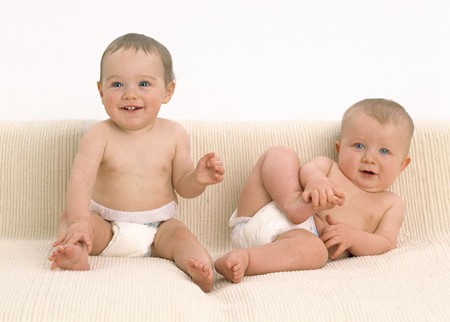Twins are born approximately one in ninety pregnancies—and this number is increasing steadily year by year. Multiple births are also on the increase.
This growth in the rate of multiple births is due to the wider availability of infertility treatment. However, parents rarely undergo this treatment with the hope of having twins or multiple births; their aim is usually to have one healthy baby-more than one at the same time is a bonus. Research confirms the following:
- Twins tend to run in families, so a woman who is herself a twin or has a twin relative is more likely to give birth to twins than a woman who has no twins in her family.
- Women who conceive after the age of forty are four times more likely to produce twins than are women who conceive at the age of twenty.
- It is quite usual for the birth of twins to follow the birth of a single child.
- Doctors are often able to identify twins as early as the sixteenth week of pregnancy.
- Most twins are born prematurely (the average gestation period is thirty-seven weeks) and are underweight.
- There is a higher incidence of crib deaths in twins.
- Twins tend to be slower to acquire speech and are more likely than other children to have speech problems that require professional help.
Twins are either identical or nonidentical. When identical twins are conceived, a single egg that is already fertilized separates into two identical parts. Each part develops into a baby. Since each child comes from the one egg, these twins (monozygotic) are always of the same sex and possess the same inherited characteristics.
When nonidentical twins are conceived, two entirely separate eggs are fertilized by separate sperm at the same time. Since each child comes from different eggs, these twins (dizygotic) are no more alike than any other brother and sister.
Studies show that even identical twins are not exactly the same in every way. While it is true that they have a greater similarity of heartbeat and pulse rate than nonidentical twins, clear differences often emerge in other areas. Parents frequently find that one identical twin is right-handed, while the other is left-handed. The left-handed child is likely to be the smaller twin. Twins often have different handwriting styles, and there are likely to be personality differences. It is normal for twins to pass developmental milestones at slightly different times. The birth order of the twins (which one actually emerged first) has no effect on the children’s psychological development. People are often fascinated by the question of which child is a few moments older than the other, especially with identical twins, because it provides a way to distinguish between the two look-alikes. The inherent danger in such labeling, particularly if it originates from the parents, is that it can cause unnecessary rivalry between the children. The so-called older twin may feel pressure to be dominant, even though she would prefer not to be. Or she may feel inadequate if the so-called younger twin develops at a faster rate.
According to a widely held view, twins have a special psychic relationship that allows them to be constantly aware of the other’s thoughts. Although no scientific evidence supports this idea, in many instances twins have fabricated a secret language between themselves. They tend to give up this form of communication before they reach school age. But the existence of a special language between children is not unique to multiple births; parents of nontwins often find their young children are able to communicate using terms adults can’t understand.
Twins present certain practical difficulties in the early years, difficulties to do with their basic management—for example, whom to give attention to first, whom to feed first, whom to pick up first when both children are crying. Indeed, the main complaint of parents, during the first twelve months after their twins’ birth, is the physical strain of managing two feeding and sleeping schedules simultaneously.
Fortunately, this very exhausting phase of the babies’ lives does pass quickly, although it might not seem that way at the time! Parents often look back on those early months as a period when they themselves became very close. They have no choice but to share child care, and this sharing process often enhances their relationship.
Once a basic routine has been established, parents then have to manage life outside the home. Have you ever tried shopping with two young children of the same age? Double strollers are available, but they are difficult to get on and off public transportation—and even harder when carrying the week’s shopping. The toddler stage carries hazards of a different sort, because the children’s increased mobility means that their parents may have two toddlers darting off in opposite directions at the same time. This is probably why twins are usually kept in their strollers for longer periods than single children.
As twins grow older, their parents have to choose whether to place both in the same class in nursery school, or whether to separate them. Separation can make starting nursery school difficult, since each child will have to manage without the support of her twin. This difficulty may be offset by the advantage that each can establish her own identity. At some point, twins do have to develop separate lives, and the longer parents delay, the harder the separation becomes for the children. Parents often report that each child positively thrives when given the chance to be in a class of her own, away from her twin, because each is treated individually.
Categories
Advertisements
Recent Articles
 How to Understand Bed Sizes – A Small Guide
How to Understand Bed Sizes – A Small Guide How to Select Some Must Have Kitchen Accessories
How to Select Some Must Have Kitchen Accessories Best Way to Change a Car Tire
Best Way to Change a Car Tire Best Way to Write an Affirmation
Best Way to Write an Affirmation Best Way to Take Charge of Your Financial Life
Best Way to Take Charge of Your Financial Life Best Way to Survive a Party When You Don’t Know Anyone
Best Way to Survive a Party When You Don’t Know Anyone Best Way to Stop Self Sabotaging Yourself
Best Way to Stop Self Sabotaging Yourself Best Way to Start Journal Writing
Best Way to Start Journal Writing Best Way to Speak with a Powerful Voice
Best Way to Speak with a Powerful Voice Best Way to Simplify Your Life
Best Way to Simplify Your Life Best Way to Respond to a Put-Down
Best Way to Respond to a Put-Down Best Way to Reduce Acne Breakouts
Best Way to Reduce Acne Breakouts Best Way to Recover from Dining Disasters
Best Way to Recover from Dining Disasters Best Way to Quit Your Job Gracefully
Best Way to Quit Your Job Gracefully Best Way to Make Your Own Website
Best Way to Make Your Own Website




Leave a Reply